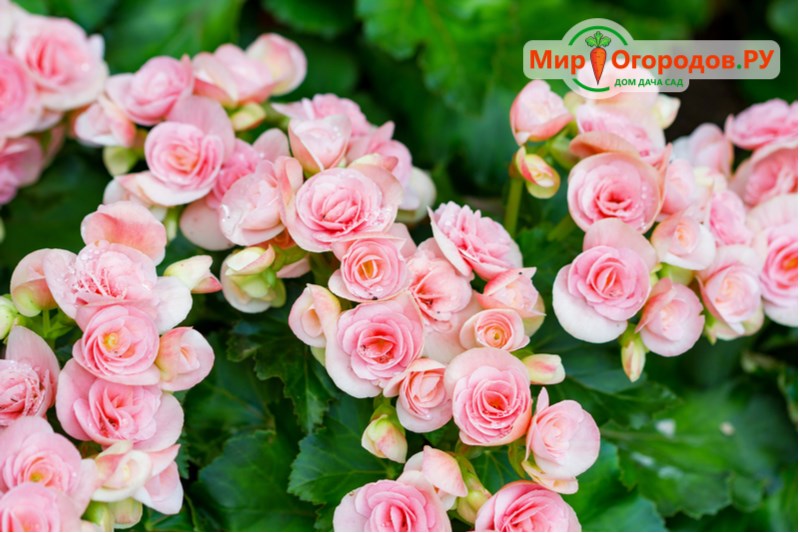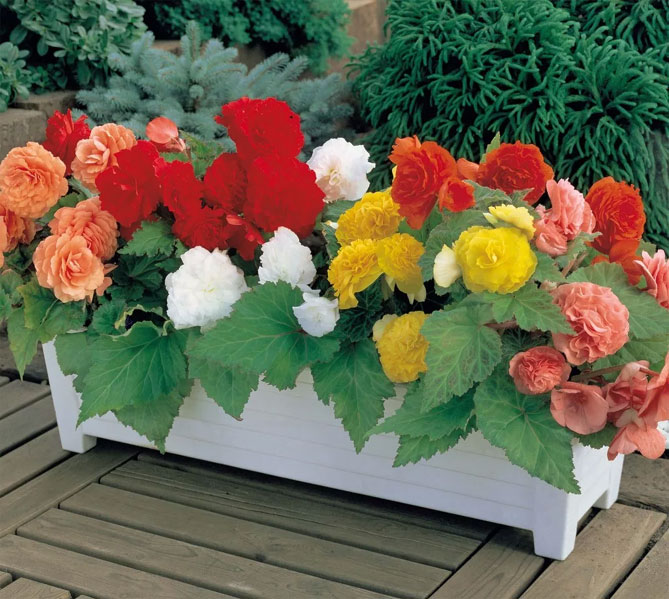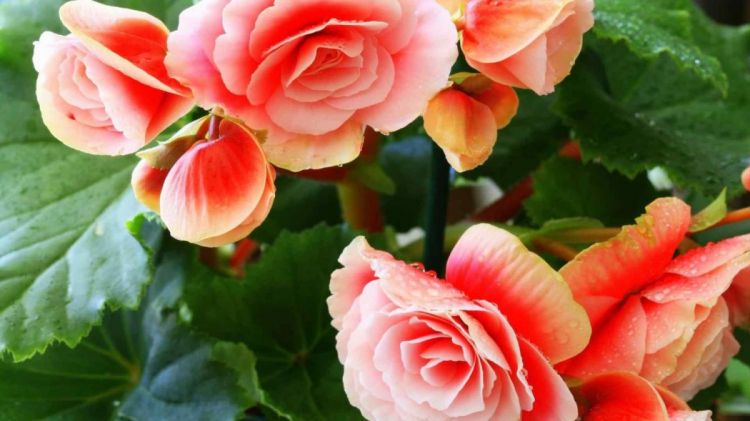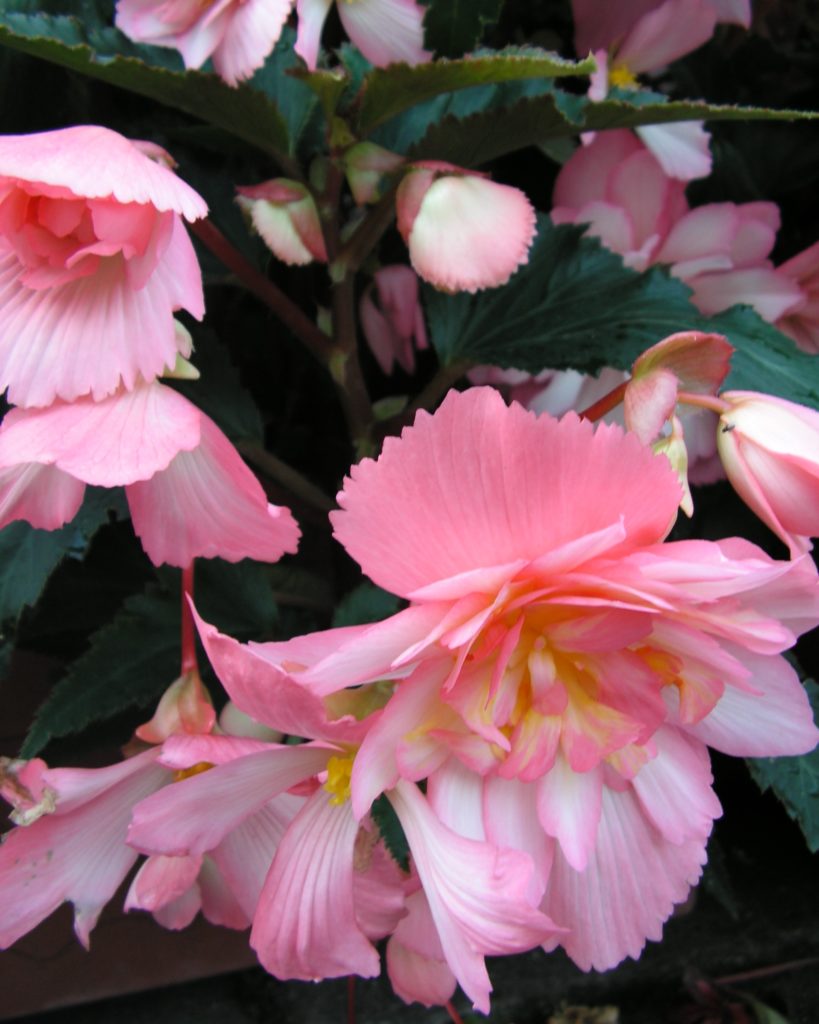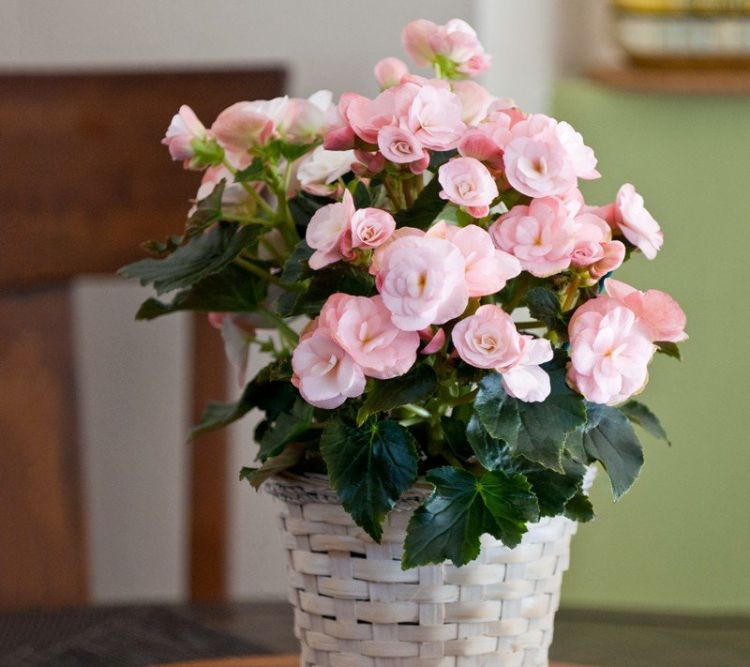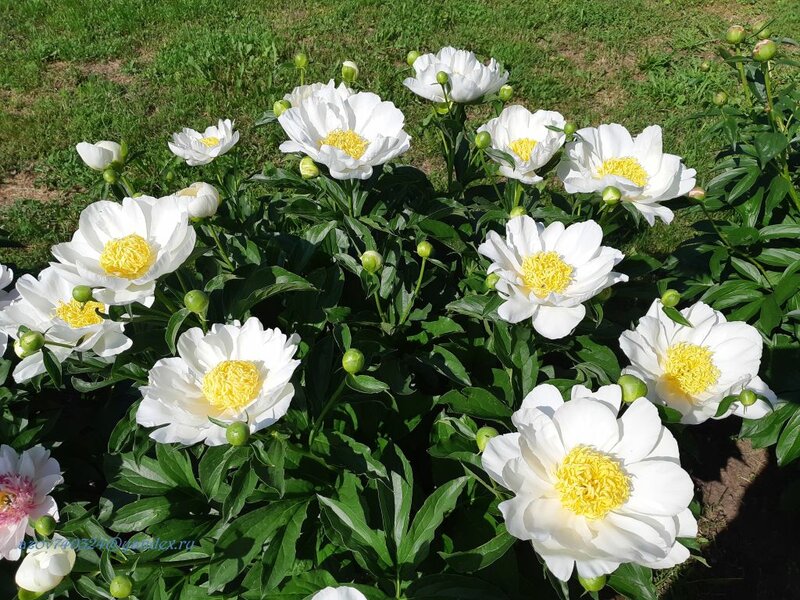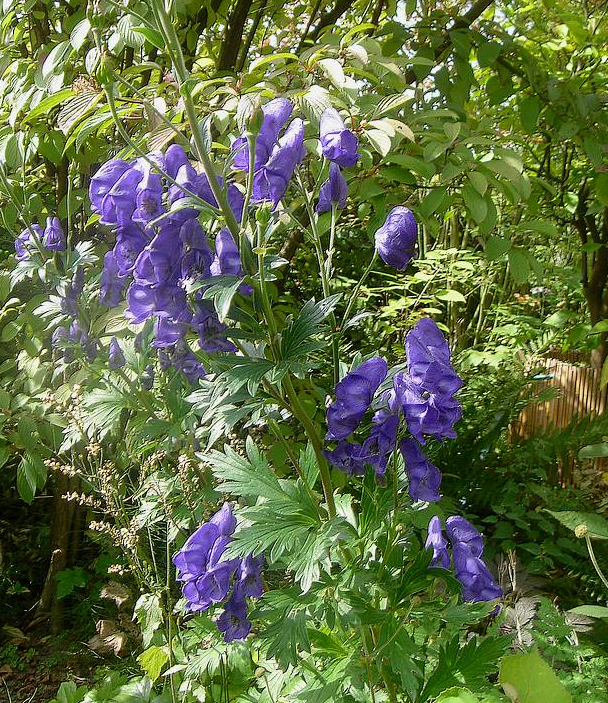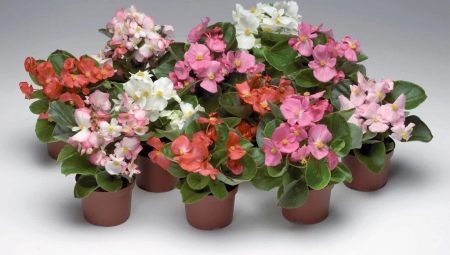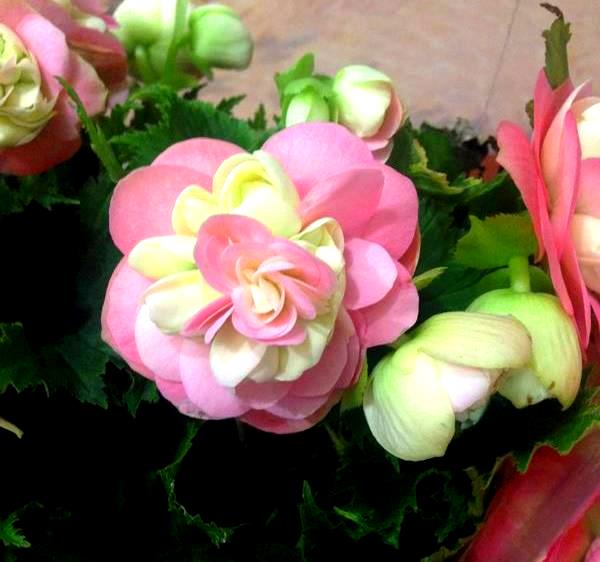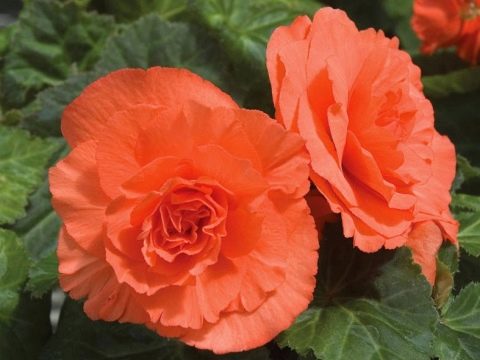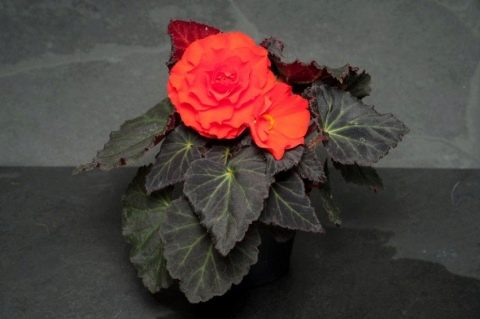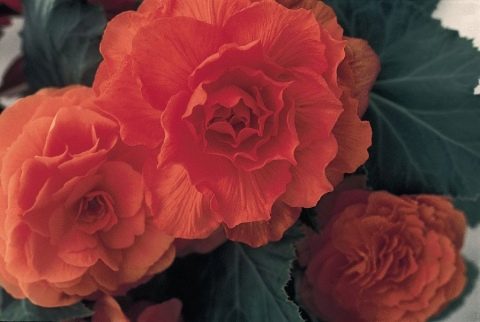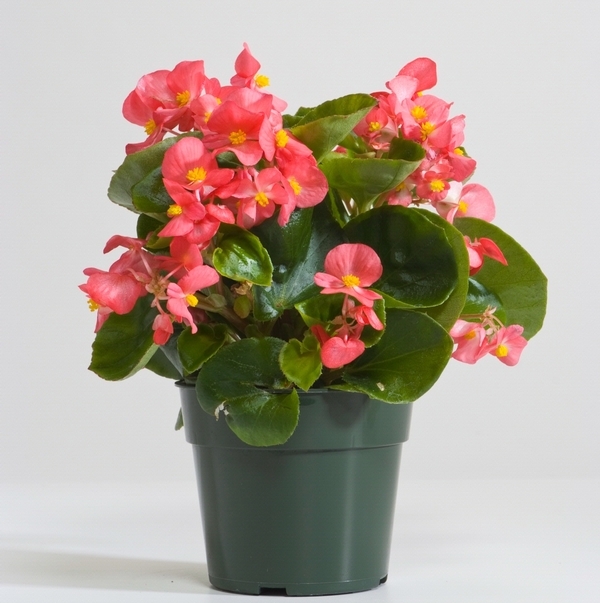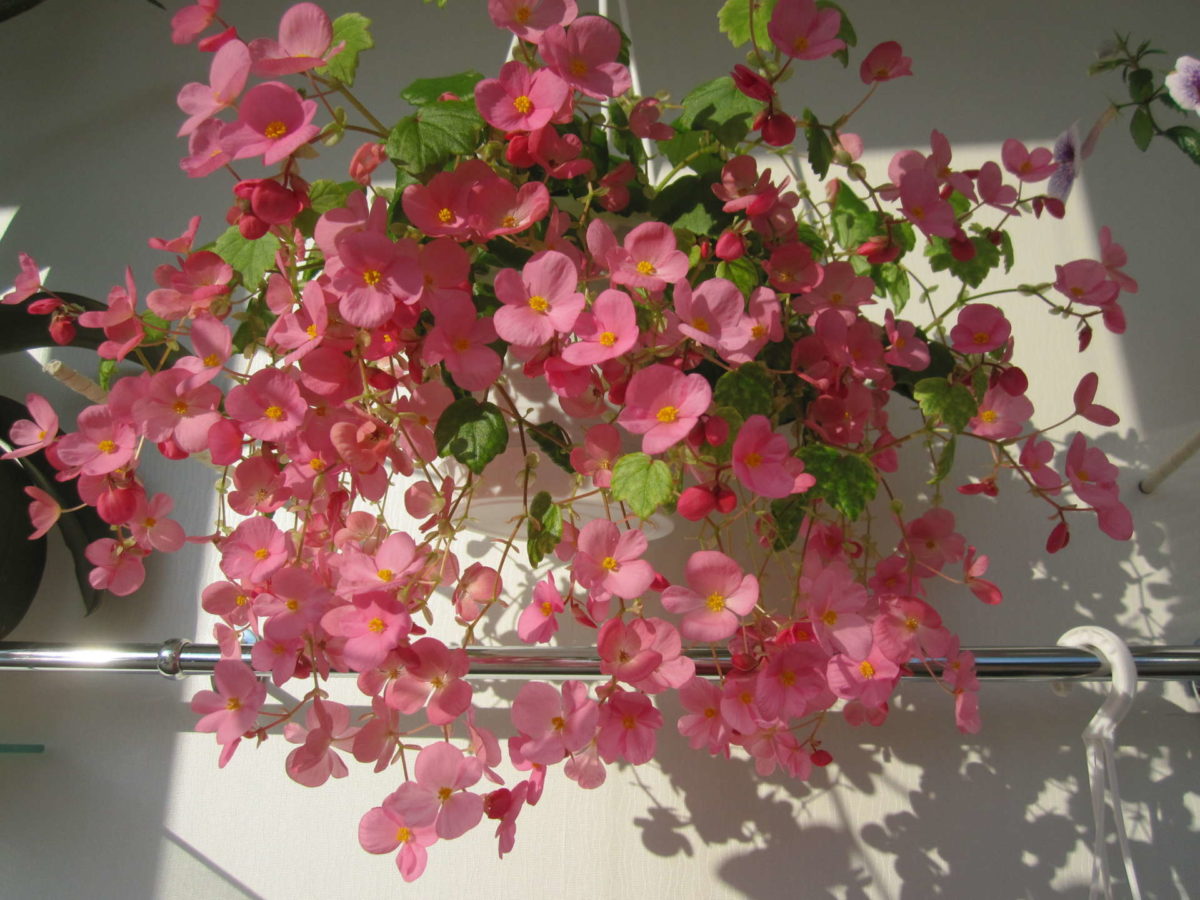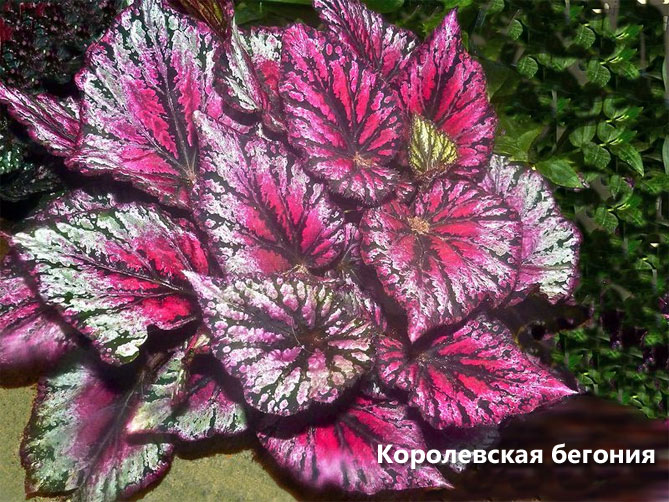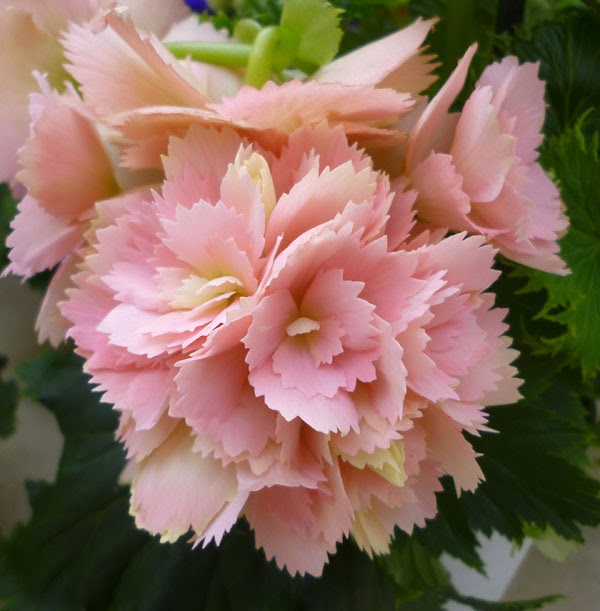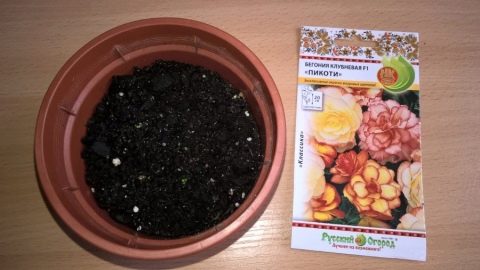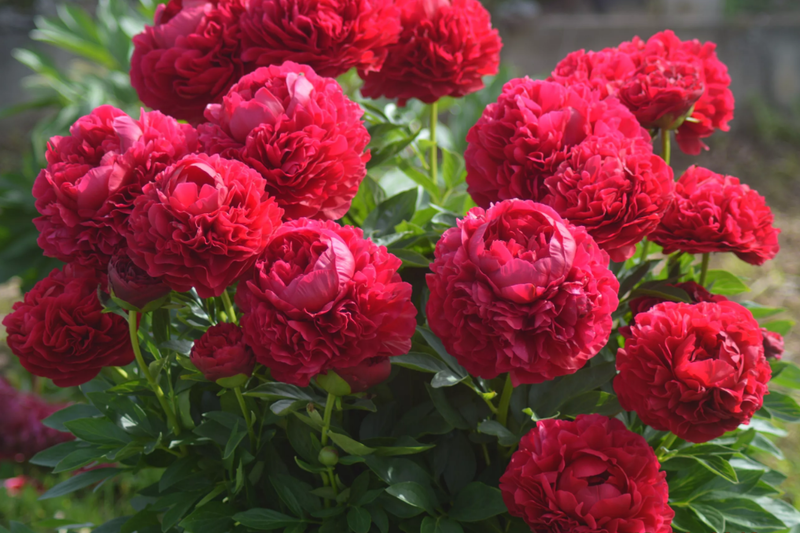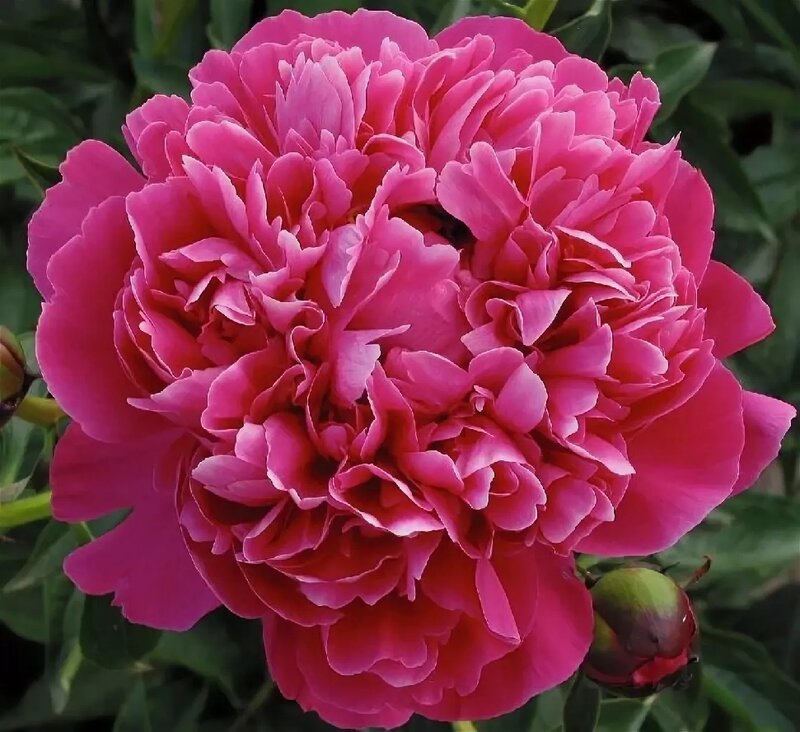Reproduction of begonias
Shank

For rooting, cut off the apical stalk 6-10 cm long
- Cut off the cutting with a top 6–10 cm long.
- Powder the cut area with crushed wood, activated carbon or ash.
- Plant in moist, loose begonias soil and cover with a jar.
- Water when the soil dries into the pan, like a regular begonia.
- With a favorable outcome, the cutting will take root and grow in 2–4 weeks.
- Gradually accustom the plant to the air in the room. You can put a peg under the neck of the jar so that at first you just ventilate the mini-greenhouse, and after 2-3 days you completely remove the jar.
- If the cutting is dry or rotten, repeat the experiment with another cutting.
All begonias that have stems can be propagated in this way.
Sheet
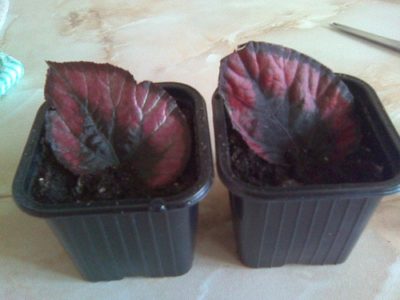
If the leaves of the begonia are medium-sized, you can grow a new plant from the leaf.
- Cut off a healthy leaf at the cutting edge with a sharp knife.
- Put the leaf in water with activated charcoal (1 tablet per glass of water).
- If the stalk begins to rot, you need to cut it to a healthy place and change the water.
- As soon as young roots are formed, plant in a permanent pot.
- When new begonia begins to grow, the leaf will dry out.
This method is good for begonias with small leaves. Large ones take root very badly, since they require a lot of nutrition, and young roots cannot cope with this task. Therefore, begonias with large leaves are propagated by leaf segments.
Part of the sheet
The first way

The leaf is cut into segments, each has at least one vein
- The leaf is cut into segments in the direction from the central vein to the edges. Each segment should have 1-3 veins.
- Lay the pieces of leaf on top of wet sand or peat, you can stick them into the ground with a cut down.
- Cover with a plastic bag or put each segment in a separate container and cover with jars.
- Keep the soil moist.
- The first shoots may appear in 1-3 months.
- Gradually accustom the begonia to the air in the apartment and remove the shelter.

On the sheet, cuts are made across the veins
Second way
- Make cuts across the center vein and the thickest veins.
- Spread the leaf out over wet begonias.
- Press down with pebbles.
- Cover the pot with plastic wrap and place in the same place where adult begonias grow.
- Keep the soil moist.
- When sprouts appear, gradually remove the shelter.

Young plants appeared in the places of incisions
Tuber
Tuberous begonias are also best propagated by cuttings or leaves. Manipulating tubers is very risky, you can lose the whole plant.
- At the end of February, after a dormant period, remove the tuber from the pot.
- If there are children, separate them and put each in a separate pot.
- If there are sprouts on the tuber, it is divided with a sharp knife so that each segment is with a sprout.
- Sections are powdered with charcoal or ash.
- Deepen the tuber pieces by half (sprouts up, slices down).
- Cover with a jar, keep the soil moist.
- When the stems are 7 cm long, bury the tuber completely.
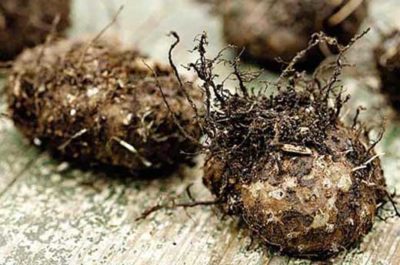
Begonia tubers with sprouts
Seeds
Against the background of the fact that begonias reproduce well vegetatively, growing from seeds is an illogical decision. However, flower growers also use this method, if neither at home nor friends have the desired variety. Then you can buy seeds in a store or from breeders and try to grow a gorgeous flower from the smallest seed. Sowing seeds is done in December-January, so that begonias bloom by the spring-summer.
- Spread the seeds over wet begonias or in peat tablets. Press the seeds to the ground, but do not bury them.
- Arrange a mini-greenhouse: cover with foil, place in a disposable container with a lid, etc.
- After 2 weeks, if the soil does not dry out and does not become waterlogged, seedlings will appear.
- Transfer the seedlings to the lightest window or supplement the lighting with lamps. Gradually remove the cover.
- When 2-3 true leaves appear, each plant can be transplanted into a pot.
A brief overview of popular ornamental leafy begonias
Royal begonia lives up to its name, as it is distinguished by exceptional decorativeness and original color of the leaves. This is a hybrid species. Large leaves (about 30 cm) have jagged edges, and are round and oval in shape.

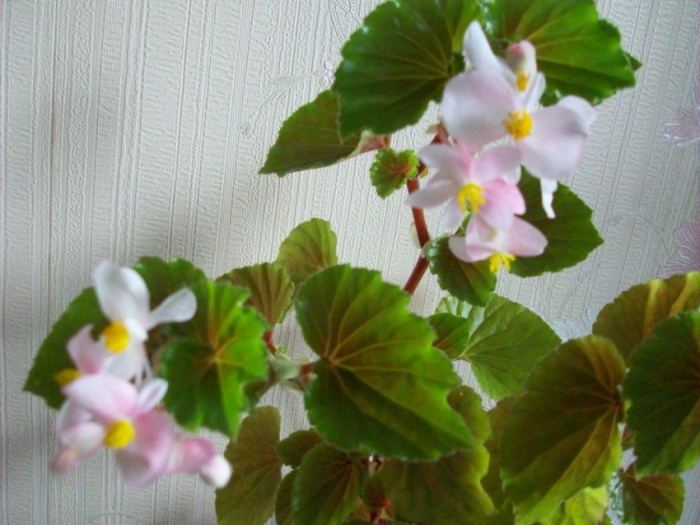
Bauer's begonia, or tiger. Tiger is called tiger because the small, heart-shaped, olive-colored leaves are covered with white spots. This indoor begonia can be found often, it is popular with flower growers. Popular varieties: Cleopatra, Tiger and others.

Caroline-leaved begonia has very thick shoots. Due to its creeping dense shoots, this begonia, large in size, takes up a lot of space on the windowsill, has deeply dissected green leaves with a noticeable pattern of veins. It is considered one of the oldest home flowers.

Grow begonias to repeat after the poet: “My begonia blossomed, lit up my window. ... All like the sun is burning. "
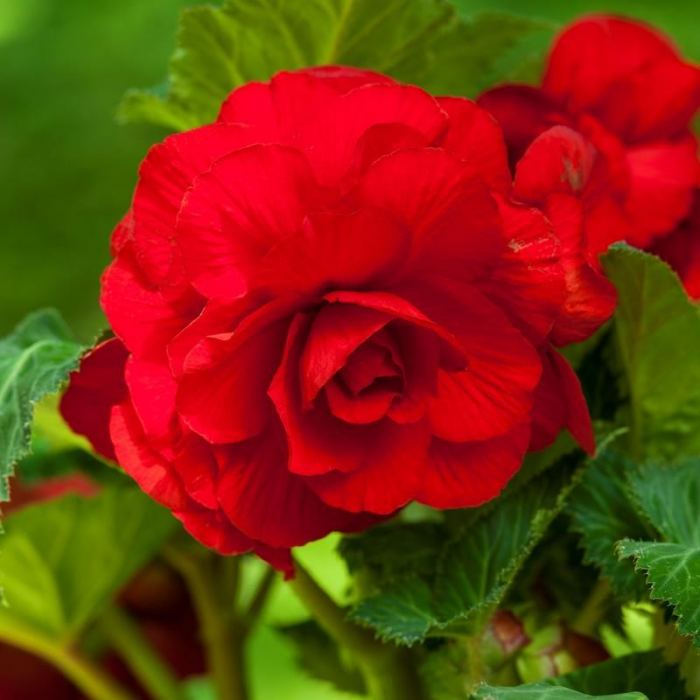
Root begonias varieties
Eternally blooming
The main difference between the species is constant flowering. In the summer, you can plant such a plant in the garden, for the winter, take it into the house, and everywhere it will bloom all year round. These are perennial herbaceous begonias. External signs, in addition to constant flowering, are rounded leaves and a small height: tall - up to 36 cm, undersized - from 8 cm.Many varieties have been bred with green or burgundy leaves, white, yellow, pink or coral flowers, which, in turn, are terry (in the form of roses) or simple.
Examples of plants in the photo
Coral
Indoor herbaceous begonias bloom in early spring and fully live up to their name. The flowers are colored in different shades of red, and the peduncles, branched and hanging under the weight of the buds, are very similar to corals. The leaves also look romantic: elongated, matte, with specks, denticles at the edges resemble the wings of angels. The most impressive begonias look in pots on stands. They are very unpretentious in leaving. The height of the bush is up to 90 cm.
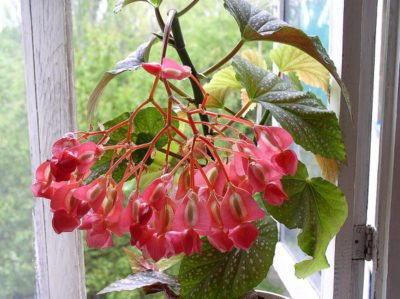
Flower stalks resemble corals in shape and color
Deciduous begonias
The species is famous for its decorative leaves, and the flowers of deciduous begonias are small and inconspicuous. Often these are non-flowering perennial plants. They differ from other species by their capriciousness. So, leafy ones cannot be kept outdoors, that is, these begonias love greenhouse conditions, high humidity, and diffused light. At the dacha or on an open balcony, they will die. The main feature of the species is large (15–20 cm) and beautiful leaves. They can be decorated with colored pearl spots, exquisite patterns, contrasting colors, silvery sheen or mother-of-pearl shimmer. The stems are pubescent, the reverse side of the leaf usually has a red tint.
6th place - begonias "Crispus Marginata" and "Marble"
I conclude my hit parade of the best begonias hybrids also with two series: "Crispa Marginata" and "Marble" begonia, since both varieties are very original and, as they say, "not for everybody."
Begonia "Crispa Marginata" in the shape of a flower is very reminiscent of a giant viola "Pansies" or a greatly enlarged flower of ever-flowering begonia. Usually, breeders strive to create tuberous begonias as double as possible. But in this case, the originators, apparently, decided to play on originality.
Begonia "Crispa Marginata" is a completely non-double variety with one row of petals. The main difference between the hybrid is a wide wavy border along the edge of the corrugated flower.Sometimes this variety is also called "Flamenco" because of the similarity of the petals to the bright robes trimmed with ruffles of Spanish dancers.
Thanks to its thick massive petals, it seems that its flowers are molded from wax. In total, there are two shades in the series: sunny yellow with a red border ("Crispa Marginata Yellow-Red") and pure white with bright red "ruffles" ("Crispa Marginata White-Red"). The transition to a bright border does not occur abruptly, but passes through the shading area of the whitened red color, and it looks very impressive. The diameter of the flower is 12 centimeters on average. The height of the bush is up to 20 centimeters.
 Begonia Crispa Marginata White-Red. ZLI
Begonia Crispa Marginata White-Red. ZLI Begonia "Marble" (Begonia Marmorata). Lyudmila Svetlitskaya
Begonia "Marble" (Begonia Marmorata). Lyudmila Svetlitskaya
Begonia "Marble" (Marmorata) in the pictures in the catalogs has very bright delightful flowers, reminiscent of a festive fireworks. On the white background of the petals there are numerous strokes and strokes of a bright scarlet color. The carved edges of the petals give an additional resemblance to fireworks. But what's wrong with this fancy strain?
And the fact is that no matter how much I tried to tame the marble begonia, it produced absolutely non-double flowers every year. A similar situation developed with all the familiar flower growers. In the best case, the flowers turned out to be semi-double (as the dissolution progressed, the yellow center was exposed). Thus, the real begonia "Marmorata" turned out to be very far from what we saw in the picture.
Moreover, its characteristic marbling really looked untidy, as if the flower had accidentally been smeared with paint. But this, of course, is a matter of taste, and perhaps someone will find its originality beautiful. The flowers of this begonia are medium-sized - up to 12 centimeters, the height of the bush is up to 25 centimeters, the shape is spreading, requires a garter.
Disadvantages of begonias "Crispa Marginata" and Marble: non-double flowers, specific appearance.
Dear Readers! Perhaps you are growing some interesting tuberous begonias that I did not mention in my article. Share your experience! I would be grateful for your feedback and comments.
4th place - fragrant begonia
Fragrant begonia (Odorata) - one of the first begonias, the flowers of which are distinguished by a very pleasant aroma. Of course, this smell cannot be called strong, and in order to feel it, you need to get close to the flower. Florists describe this smell in different ways, but I associate it with the sour-sweet smell of lemon cheesecake.
The most common hybrid is called "Angelica". It is very difficult to describe the color of the flowers of this variety. The basic tone of the petals is pure white, and the buds have a reddish blush, with complete dissolution in the center of the flower, you can also see yellow areas.
The most interesting color - lemon yellow with small pinkish markings - distinguishes Odorat's "Sunny Dream" begonia. Other colors of the series: bright pink "Pink Delight", red "Red Glory" and white "Fragrant White". The structure of the fragrant begonia flower resembles the series "Non-stop" - they are also not too large in size and rarely reach 10 centimeters. The edges of the petals are slightly jagged.
Although, according to the classification, this variety is not classified as ampelous, the flowers of fragrant begonia have long drooping peduncles, like in ampelous varieties. Erect shoots no more than 20 centimeters high.
Disadvantages of Odorata begonias: medium-sized flowers, drooping peduncles (it is better to plant them in hanging baskets).
 Fragrant begonia (Odorata). telegraphgarden
Fragrant begonia (Odorata). telegraphgarden
Elatior begonia varieties
These amazing hybrid begonias have more than a hundred varieties. Among the begonias of the Elatior group, there is an internal division into ordinary small-flowered varieties and large-flowered hybrids, which are also called Rigen begonias. They are more stable and large-colored, most often terry.
Such varieties as:
- dark-leaved pink-red with almost purple leaves ‘Grace’;
- snow-white dark-leaved variety 'White Pearl';
- dark-leaved variety with apricot-salmon shade of flowers ‘Lax’;
- double dark pink with wavy leaves ‘Borias’;
- raspberry variety 'Berseba';
- red-orange-yellow watercolor varieties of the 'Bodini' series;
- ampelous semi-double series with clusters at the ends of the shoots ‘Cottage Collection’;
- bright yellow variety 'Nadine';
- pink with teardrop-shaped petals ‘Sweet Dreams’;
- semi-double green and white graceful 'Clara' variety.
It is worth choosing varieties purely by color - both flowers and leaves. They often remain unnamed in catalogs.
How to reproduce?
Reproduction is possible both by cuttings and by seeds, tubers. If you want to preserve the characteristic features of the variety, it is better to choose the seed method. Begonias are sown on the surface of the earth in winter, organizing additional lighting if necessary, then covered. Periodically you can spray, dive.
Tuberous method:
- extracting a wilted plant from the soil;
- placing it in a container filled with sand and peat for wintering;
- periodic watering;
- cleansing and planting.

Division:
- after wintering, the tuber must be divided into parts with buds;
- roll in ash;
- planted in moistened soil, covered with polyethylene, removed to the light;
- transplanted after the appearance of foliage.
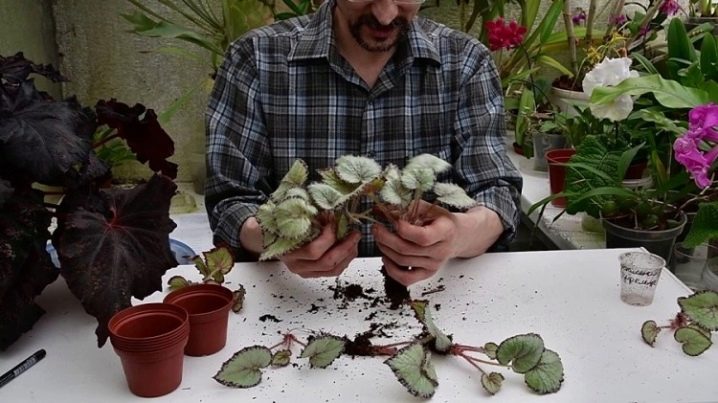
Cuttings:
- it is necessary to choose cuttings with 2 buds (there may be more);
- foliage is partially removed;
- sand and peat are mixed, 3 parts to one;
- the stalk is removed into the mixture and covered with polyethylene;
- periodically ventilated while waiting for the roots.
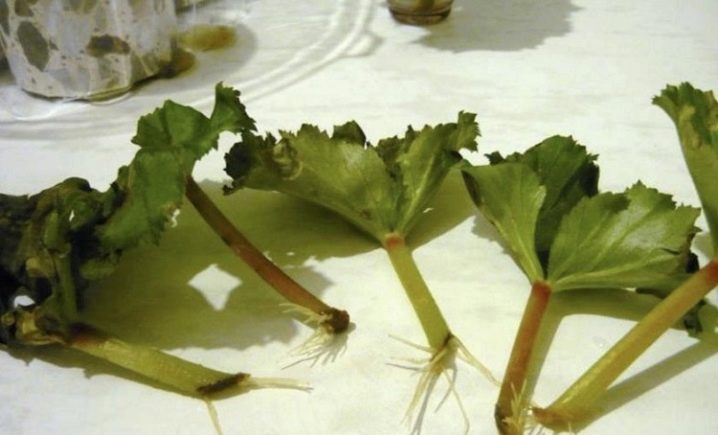
A bit of classification
Among the types of begonia there are shrubs and shrubs, sometimes the so-called climbing, as well as annual and perennial herbaceous plants. In the botanical classification, rhizome and tuberous begonias are distinguished.
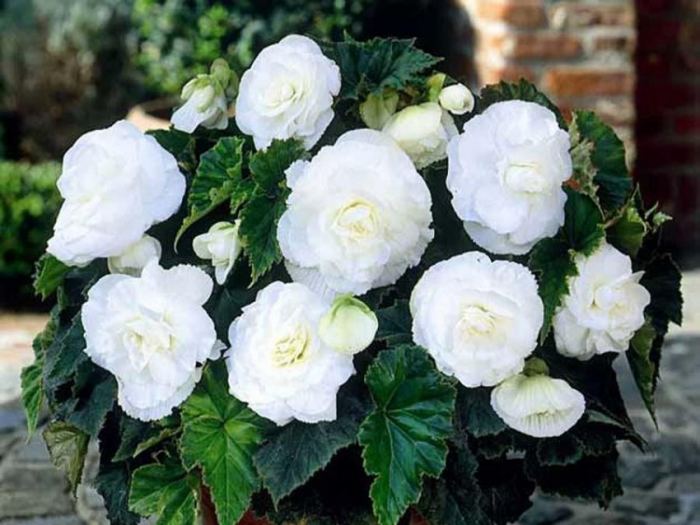
For a non-professional lover of indoor and garden plants, it is much more important to know that, firstly, begonias are tall, creeping, ampelous; secondly, evergreen or with leaves falling off during the dormant season.
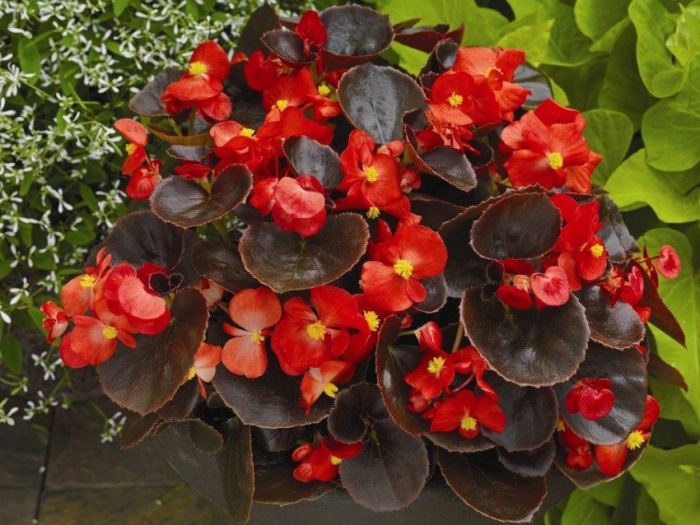
 The fact is that all begonias can be conditionally divided into decorative flowering and decorative deciduous. That is why you can find photos of plants with small or large, smooth or double, pink, white or yellow flowers, or plants are not blooming at all, but surprising with the color of their leaves, and all these will be images of begonias.
The fact is that all begonias can be conditionally divided into decorative flowering and decorative deciduous. That is why you can find photos of plants with small or large, smooth or double, pink, white or yellow flowers, or plants are not blooming at all, but surprising with the color of their leaves, and all these will be images of begonias.
Diseases and pests
Begonia is afraid of waterlogging, and therefore dampness can lead to decay of the roots. Moreover, in excessively damp ground, various fungi can appear. The most common fungus - gray rot - affects the leaves, it can be identified by a gray bloom on the upper side of the leaf, the buds are also affected (a slimy bloom appears on them). You can get rid of gray rot by spraying the plant with raster soap and copper sulfate (20 grams of soap and 2 grams of vitriol are dissolved in a liter of water). Also, powdery mildew may appear from dampness - light gray spots on the leaves. It is easy to cope with it - just wipe the leaves with soapy water. Also, begonia can be struck by aphids - a small insect that sucks juice from leaves. Aphids can also be removed with soapy water; special chemicals also help well.
Most of all begonia is prone to rot. Pay close attention to the irrigation regime - do not allow stagnation of water in the soil.
Rot is manifested in the blackening of the stems, it spreads very quickly
It is important to quickly remove decaying stems to prevent the death of the plant, and treat the flower with a fungicide. Blackening of stems and leaves can cause bacterial mottling, which begins with small vitreous spots on the inside of the leaf.
It is useless to fight it, you need to discard the affected plant and disinfect the ground. To prevent bacterial spotting, begonias are sprayed with a solution of copper oxychloride.
We hope these tips will help you grow healthy tuberous begonias that will delight you with beautiful lush flowers in your garden or at home for many years.
The attraction of ever-flowering begonia
There are many interesting species in the genus Begonia L. Tuberous begonias and always-flowering begonias (ever-flowering) are in the lead among flowering ones. This complex hybrid holds the record for the longest flowering time. Even in winter, there are so many flowers on the bushes that in some varieties and hybrids they cover the leaves with themselves. Two-tone and terry forms are especially good. The unpretentiousness of this plant is also surprising.
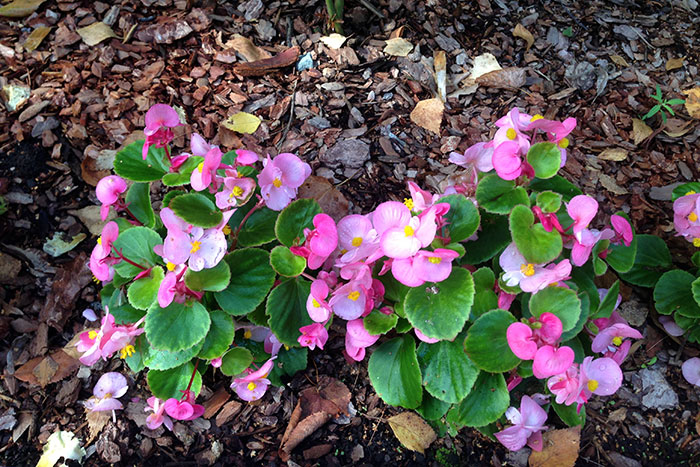
Delicate color of flowers of ever-flowering begonia (always flowering)
The rainforests of Brazil are considered the birthplace of ever-flowering begonias (ever-flowering). However, without the labor of breeders, we would not have seen the modern "girl's beauty". Professional flower growers and indoor plant lovers love the flower-strewn bushes with shiny green or burgundy leaves and white, pink or red flowers. The ever-flowering begonia has managed to adapt to life far from the tropics. Varieties and hybrids have been developed for different living conditions. Some are resistant to direct sunlight, heat and temporary drought, while others can grow and bloom in the northern regions.



